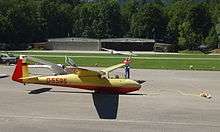Schleicher Ka 2 Rhönschwalbe
| Ka2 Rhönschwalbe | |
|---|---|
 | |
| A Ka–2 on landing | |
| Role | two-seat training glider |
| National origin | Germany |
| Manufacturer | Alexander Schleicher GmbH & Co |
| Designer | Rudolf Kaiser |
| First flight | Spring 1953 |
| Produced | 1953 - 1957 |
| Number built | Ka–2 42 built, Ka–2b 75 built |
The Schleicher Ka-2 Rhönschwalbe is a tandem two-seat training glider designed and built in Germany, in 1952.
Design and development
Designed by Rudolf Kaiser, the Ka-2 was an all wooden glider with plywood and aircraft fabric covering. The Ka-2s wings, with marked forward sweep and dihedral are mounted above the fuselage, flanking the rear cockpit. The front cockpit is covered by a one piece plexiglas canopy which opens to the right and the rear cockpit is covered by a canopy incorporating the inner leading edges of the wing, opening rear-wards, held in place by the front canopy when closed.[1]
The undercarriage of the Ka-2 comprises a large rubber-sprung wooden skid under the forward fuselage in front of a non-retractable semi recessed mainwheel, as well as a steel rubber-sprung tail-skid. Conventional controls are fitted with ailerons on each wingtip trailing edge, elevator with anti-balance trim tab behind the tailplane and rudder aft of the fin. Schempp-Hirth airbrakes, at 38% chord and approx ⅓ span, open out above and below the wing to provide approach control.[1]
Performance of the Ka-2 was found to be lower than expected, due to the relatively high wing loading. Schleicher introduced the Ka2b, increasing the wingspan from 15 m (49 ft) to 16 m (52 ft), to improve the efficiency of the wing. Fuselage length was also increased by 18 cm (7.1 in) to 8.15 m (26.7 ft) to maintain stability margins in pitch.[1]
Performance of the Ka-2b was improved in weak thermals due to a lower minimum sink speed, allowing tighter thermalling. Cross-country performance was also improved by a higher glide ratio, increasing the chance of reaching the next thermal. The standard competition handicap for the Ka–2 is 74 and the Ka-2b handicap is 78.[1]

Operational history
The Ka-2 and Ka-2b saw extensive use in gliding clubs throughout Germany and Europe and the Ka2b was also used in several record attempts; On 24 January 1959 Dieter Schmitt and Karl Pummer climbed a Ka-2b 6,907 m (22,661 ft) in lee wave lift at Fayence in France for a new German National two-seater record climb. Later the same day flying to 7,700 m (25,300 ft) to set a new German two-seater absolute altitude record.
A Ka2b also set a distance record for two seaters in Germany of 424.5 km (263.8 mi; 229.2 nmi) in 1964 and again on 28 May 2012 at 684 km (425 mi; 369 nmi), flown by Uli Schwenk and his 81-year-old father.
Variants
- Ka-2
- The initial production glider with a 15 m (49 ft) span wing and 7.97 m (26.1 ft) long fuselage.
- Ka-2b
- An improved performance version with 16 m (52 ft) span wings and 8.15 m (26.7 ft) fuselage.
Specifications (Ka-2)
Data from Sailplanes 1945-1965,[2] and The World's Sailplanes:Die Segelflugzeuge der Welt:Les Planeurs du Monde[3]
General characteristics
- Crew: 2
- Length: 7.97 m (26 ft 2 in)
- Ka-2b: 8.15 m (26.7 ft)
- Wingspan: 15 m (49 ft 3 in)
- Ka-2b: 16 m (52 ft)
- Height: 1.7 m (5 ft 7 in)
- Wing area: 16.8 m2 (181 sq ft)
- Ka-2b: 17.5 m2 (188 sq ft)
- Aspect ratio: 13.4
- Ka-2b: 14.63
- Airfoil: Wing root: Göttingen 533 modified 16%, Mid span: Göttingen 533 14%, Wing tip: Göttingen 533 12%
- Empty weight: 254 kg (560 lb)
- Gross weight: 460 kg (1,014 lb)
- Ka-2b: 480 kg (1,060 lb)
Performance
- Stall speed: 58.5 km/h (36 mph; 32 kn)
- Never exceed speed: 170 km/h (106 mph; 92 kn) in smooth air
- Rough air speed max: 130 km/h (81 mph; 70 kn)
- Aerotow speed: 130 km/h (81 mph; 70 kn)
- Winch launch speed: 100 km/h (62 mph; 54 kn)
- g limits: +4g at 126 km/h (78 mph; 68 kn), -2g at 168 km/h (104 mph; 91 kn)
- Rate of sink: 0.9 m/s (180 ft/min) at 65 km/h (40 mph; 35 kn) at 415 kg (915 lb)
- Ka-2b: 0.8 m/s (160 ft/min) at 62 km/h (39 mph; 33 kn) at 415 kg (915 lb)
- Lift-to-drag: 26:1 at 80 km/h (50 mph; 43 kn) at 415 kg (915 lb)
- Ka-2b:27:1
- Wing loading: 27.4 kg/m2 (5.6 lb/sq ft) at 460 kg (1,010 lb)
- Ka-2b: 27.4 kg/cm² (5.62 lb/sqft) at 480 kg (1,060 lb)
See also
- Related development
Notes
- 1 2 3 4 Seliger, Peter F. (1 January 2003). Rhön-Adler. 75 Jahre Alexander Schleicher Segelflugzeugbau (in German). Frankfurt a.M.: R. G. Fischer Verlag. ISBN 3830104375.
- ↑ Simons, Martin (2006). Sailplanes 1945-1965 (2nd revised ed.). Königswinter: EQIP Werbung und Verlag. pp. 80–82. ISBN 978-3-9807977-4-0.
- ↑ Shenstone, B.S.; K.G. Wilkinson (1958). The World's Sailplanes:Die Segelflugzeuge der Welt:Les Planeurs du Monde (in English, French, and German) (1st ed.). Zurich: Organisation Scientifique et Technique Internationale du Vol a Voile (OSTIV) and Schweizer Aero-Revue. pp. 82–87.
References
- Simons, Martin (2006). Sailplanes 1945-1965 (2nd revised ed.). Königswinter: EQIP Werbung und Verlag. pp. 80–82. ISBN 978-3-9807977-4-0.
- Shenstone, B.S.; K.G. Wilkinson (1958). The World's Sailplanes:Die Segelflugzeuge der Welt:Les Planeurs du Monde (in English, French, and German) (1st ed.). Zurich: Organisation Scientifique et Technique Internationale du Vol a Voile (OSTIV) and Schweizer Aero-Revue. pp. 82–87.
- Seliger, Peter F. (1 January 2003). Rhön-Adler. 75 Jahre Alexander Schleicher Segelflugzeugbau (in German). Frankfurt a.M.: R. G. Fischer Verlag. ISBN 3830104375.
Further reading
- Richard und Monique Ferrière: Les Planeurs et Motoplaneurs d' Alexander Schleicher 1951–1981. Motorbuch-Verlag, Stuttgart 1988, ISBN 3613011905.
External links
| Wikimedia Commons has media related to Ka 2. |